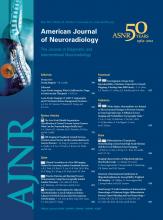We read the article by Carrara et al,1 entitled “A Distinct MR Imaging Phenotype in Amyotrophic Lateral Sclerosis: Correlation between T1 Magnetization Transfer Contrast Hyperintensity along the Corticospinal Tract and Diffusion Tensor Imaging Analysis,” with great interest. The possible recognition of a distinct phenotype of amyotrophic lateral sclerosis (ALS) based on typical corticospinal tract (CST) hyperintensity on T1-weighted images with magnetization transfer contrast (T1 MTC) reinforces the applicability of MR imaging in confirming upper motor neuron (UMN) involvement in ALS. However, previous reports have described false-negative MR imaging results that were attributed to progressive CST degeneration in the advanced stages of the disease.2,3 Nevertheless, to the best of our knowledge, this theoretic “pseudonormalization” has never been documented in the MR imaging follow-up of a patient with ALS.
We describe imaging follow-up of a young-adult patient with ALS (a 20-year-old woman) who was examined in the 6th and 30th months after the initial clinical manifestations of UMN involvement. The MR imaging protocol included T1 MTC (TR/TE, 512 ms/minimum full; MT pulse, 1200 Hz; off resonance). For quantitative assessment, we obtained axial proton density sequences (TR/TE, 2200/30 ms) with and without MTC to determine the magnetization transfer ratios (MTRs). All MR images were obtained in the same 1.5T scanner with identical parameters for monitoring. On the first MR imaging scan, there was a marked abnormal CST hyperintensity on the T1 MTC images, which became almost inconspicuous on follow-up MR imaging (Fig 1). The MTRs of a 3-mm-diameter circular region of interest were measured in the bilateral CST in the subcortical precentral regions, the posterior segment of the internal capsules, and the extramotor bilateral frontal white matter (Table). It is possible to realize a significant reduction of MTR values in all different regions, consistent with the findings of the conventional sequence.
First MR imaging scan (6th month after the initial clinical manifestations of UMN involvement). A and B, Axial T1 MTC images show symmetric abnormal hyperintensity along the CST in the internal capsules (arrowheads) and in the cortical and subcortical precentral regions. C and D, Imaging follow-up (30th month). Axial T1 MTC images indicate a “pseudonormalization” of the CST signal intensity at the same locations.
CST and white matter MTR
Our findings are consistent with those previously reported and reinforce the utility of T1 MTC sequences for the early diagnosis of UMN degeneration based on qualitative analysis of the CST.4 The typical hyperintensity on T1 MTC likely reflects the abnormalities that are restricted to the CST in the initial UMN degeneration events in definite ALS. This likely reflects the abnormalities that are restricted to the CST in the initial UMN degeneration events in definite ALS. However, pseudonormalization limits this sequence applicability in advanced ALS, likely as a consequence of the gliosis that is secondary to axonal loss and CST degeneration.2,3 Our quantitative results support this argument to explain the pseudonormalization documented on T1 MTC signal intensity. Disease progression is presumably followed by some changes in the microstructural tissue environment that modify the exchange basis of magnetization transfer; furthermore, this progression leads to widespread abnormalities beyond the CST limits, as confirmed on DTI.3 As shown here, MTR is useful to estimate the structural damage in different brain regions, including motor and extramotor ALS progression, particularly in advanced stages of UMN compromise in patients with ALS.2,3
References
- © 2012 by American Journal of Neuroradiology








